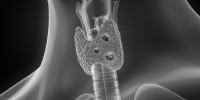
Inhibition of One Carbon Metabolism
Unlike what they had expected, researchers found that the resistance of 8505C ATC cells to cell death is attributed to their ability to induce one carbon metabolism, which helps them maintain redox balance during the inhibition of glutamine metabolism. Moreover, they noticed that inhibiting both glutamine metabolism and one carbon metabolism together was more effective at reducing cell proliferation and improving the efficacy of lenvatinib and sorafenib, which are tyrosine kinase inhibitors used to treat ATC.
Anaplastic thyroid cancer (ATC) is a rare and deadly type of thyroid cancer that requires chemotherapy after surgery. Traditional chemotherapy has limited success, and new therapies targeting tyrosine kinase have been developed, but more effective treatment is still needed.
Recent studies have shown that glutamine metabolism plays an important role in the growth of ATC tumors, as ATC cells have higher levels of glutaminase 1 and glutamate dehydrogenase compared to other thyroid cancers. Glutamine is a crucial amino acid for tumor growth, as it is involved in the tricarboxylic acid cycle, which is important for mitochondrial function and antioxidant balance. Inhibition of glutamine metabolism can lead to stress in cancer cells, but ATC cells have been found to adapt to this stress by promoting one carbon metabolism, a pathway involved in the synthesis of amino acids, lipids, and reactive oxygen species (ROS) balance through glutathione synthesis.
New Study Reveals One Carbon Metabolism as Potential Therapeutic Target for ATC Treatment
Based on strong relationship between glutamine metabolism and biological features of ATC, researchers hypothesized ATC are vulnerable to glutaminolysis inhibition – and they've just published their study and their findings on Research Square.
 To investigate the functional mechanism against glutamine metabolism inhibition, we conducted mRNA and ATAC-Sequencing data analysis and found that glutamine deprivation increased ATF4-mediated one carbon metabolism.
To investigate the functional mechanism against glutamine metabolism inhibition, we conducted mRNA and ATAC-Sequencing data analysis and found that glutamine deprivation increased ATF4-mediated one carbon metabolism.
Unlike what they had expected, they found that the resistance of 8505C ATC cells to cell death is attributed to their ability to induce one carbon metabolism, which helps them maintain redox balance during the inhibition of glutamine metabolism. Moreover, they noticed that inhibiting both glutamine metabolism and one carbon metabolism together was more effective at reducing cell proliferation and improving the efficacy of lenvatinib and sorafenib, which are tyrosine kinase inhibitors used to treat ATC.
Through single-cell analysis, they also observed that ATC cells may enhance one carbon metabolism during the evolutionary process from papillary thyroid cancer (PTC). These findings suggest that ATC cells may use one carbon metabolism to adapt to various stressors, including metabolic stress and chemotherapy, and that targeting this pathway could be a promising therapeutic approach for ATC.